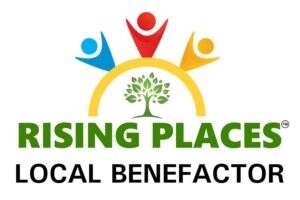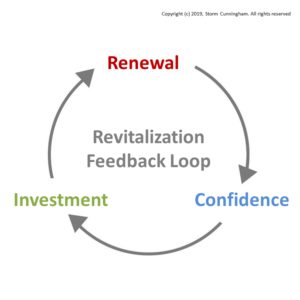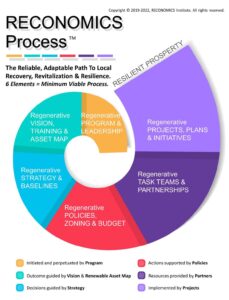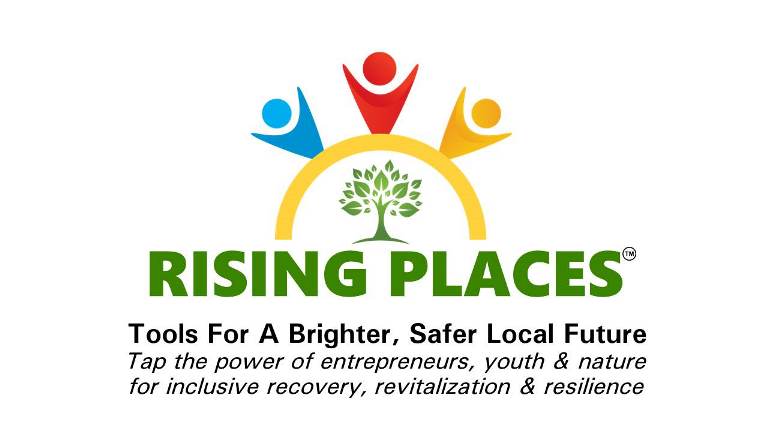On January 1, 2024, a powerful new community revitalization and resilience tool will burst onto the scene: RISING PLACES. It’s an initiative of RECONOMICS Institute, but will have its own site at RisingPlaces.org.
There’s no shortage of online tools purporting to help solve community problems these days. Most are well-meaning, and many are actually useful…but only in a symptomatic manner. In other words, they reduce a certain type of pain (social, economic, environmental, etc.) without actually addressing the most fundamental issue: the community’s trajectory.
If a community’s economy and quality of life are bad and getting worse (a downward trajectory), it’s difficult to effectively address issues life climate resilience, brownfield cleanups, heritage renewal, affordable housing, public transit, crime, etc. The resources—and often the will—just aren’t there. Likewise with a stagnating place (a flat trajectory).
On the other hand, if the economy and quality of life are bad but getting better (an upward trajectory), a vast array of solutions become possible.
Because now, investors, employers and potential new residents have more confidence that a place that’s improving, which creates a positive feedback loop: the more a place revitalizes, the more it can revitalize.
And, if it’s improving in a way that benefits all—not just a privileged few—then seemingly intractable problems like crime, drugs and homelessness can also be effectively addressed. This adds social and economic resilience.
So, how does one turn a flat or downward trajectory into an upward one? The most fundamental issue is renewal capacity: the ability of local leaders and residents to turn resources into revitalization. Lack of renewal capacity is evident when you see leaders waste precious funding on feel-good activities that produce documents without action, or on superficial “eyewash” like street banners and planters. Don’t get me wrong: beautification is important, but it’s only a tactic, not a strategic process.
Thus, there are four essential things an online tool must do in order to effectively help a place revitalize in a resilient manner (not just a brief burst of renewal, such as from a redevelopment project):
- Educate: renewal capacity comes in large part from understanding the factors that both inhibit and advance revitalization and resilience;
- Listen: A solution that addresses the specific aspirations and challenges of a community can only be created when a broad swath of the population voices their dreams and concerns…not just the privileged few who aren’t working two or three jobs, and have the time to attend a 4-hour visioning session (or a 4-day design charrette);
- Build capacity: it must address the fundamental issue… boosting local renewal capacity to create an upward trajectory. This doesn’t just mean economic growth; regeneration improves both the economy and the society by repurposing, renewing and reconnecting the natural and built environments;
- Activate: Nothing is reliably produced without a process, so if you want your actions to actually produce revitalization and/or resilience you need a blueprint for creating that process…one that’s attuned to your community’s specific needs and capabilities.
Those four characteristics describe the RISING PLACES Tools offered by RISING PLACES.
The communities that use the RISING PLACES Tools will form the first global network of neighborhoods, cities and counties where quality of life, health, infrastructure, housing and economic opportunity are being enhanced for all.
One of the primary purposes of the site is to serve an unmet need of public and private funders: it will help them find more productive targets for their grants, loans and real estate investments.
 For those of you who own or lead a business, there’s an opportunity to activate your local community on RISING PLACES as a Local Benefactor. Activation provides all leaders and residents with permanent, free access to the RISING PLACES Tools on the site.
For those of you who own or lead a business, there’s an opportunity to activate your local community on RISING PLACES as a Local Benefactor. Activation provides all leaders and residents with permanent, free access to the RISING PLACES Tools on the site.
The tools help the community boost its renewal capacity: its ability to efficiently and effectively turn funding and other resources into lasting, equitable revitalization that benefits all.
Too many communities waste transformative opportunities. They squander precious influxes of money on expensive revitalization plans that are subsequently ignored, or on redevelopment projects that—even when successful for a given property—don’t reverse the downward trend of the overall neighborhood or community.
Likewise with local climate resilience efforts that don’t gain traction because they are planned and designed in the “resilience silo”: they fail to address other urgent community needs like affordable housing, quality of life, economic opportunity, etc.
Federal and state agencies, foundations and private redevelopers all have one thing in common: they prefer to invest in communities that know how to put their investments to good use. This increases both safety and ROI (return on investment). The current condition of a community is less important than its trajectory: a rising place lifts all boats.
But first, here’s a brief introduction to what Rising Places is, who it serves and how it works.
WHAT IS RISING PLACES?
Currently, those working to revitalize communities—or to make them more resilient—have to rely on generic tools like PowerPoint, GIS, Facebook, project management, email polls, etc.
RISING PLACES provides tools specifically engineered to regenerate places in an inclusive, equitable manner. It’s the world’s first social media, collaboration and public research tool designed to quickly advance efficient, inclusive, green economic renewal (urban or rural).
Agencies, non-profits and foundations license the software for local use, providing all local stakeholders with a free (to them), easy, more harmonious way to grow a strong, green, equitable economy.
 RISING PLACES is the all-in-one community renewal site, where people work together to enhance their local future. Resilience, revitalization and disaster recovery are all based on the same regenerative actions. But they are normally pursued in separate silos, leading to delays, waste and failure. When integrated, success is faster, better, cheaper and more reliable.
RISING PLACES is the all-in-one community renewal site, where people work together to enhance their local future. Resilience, revitalization and disaster recovery are all based on the same regenerative actions. But they are normally pursued in separate silos, leading to delays, waste and failure. When integrated, success is faster, better, cheaper and more reliable.
Corporations, non-profits, foundations, individual philanthropists and local governments can all support their local community—and our shared planet—by becoming a Local Benefactor of RISING PLACES.
You can proudly display your RISING PLACES Benefactor logo in your ads, or on your website, showing that you help make places better. Benefactors will appear in RISING PLACES advertising, editorials, articles and our other promotional exposure.
Once a Local Benefactor registers their community, everyone in that city or county (residents and leaders alike) gets permanent, FREE access to the RISING PLACES Tools. The Local Benefactor is exclusively featured in the Local Benefactor Banner on that community’s RISING PLACES Page for 5 years, with the right of first refusal for renewing as the Local Benefactor.
 That continuous progress builds confidence in a better local future. That confidence, in turn, attracts jobs, residents and investment, which leads to more revitalization, which creates more confidence.
That continuous progress builds confidence in a better local future. That confidence, in turn, attracts jobs, residents and investment, which leads to more revitalization, which creates more confidence.
This creates a positive feedback loop whereby revitalization begets revitalization, decreasing dependence on external inputs. Funders love that.
The resulting data will feed the Rising Places Report, which will attract employers and real estate investors to these rising places.
A “rising place” is simply a community or region where the economy and quality of life are improving. The trajectory is what counts: not the current condition.
Resilient prosperity arises when:
- economic growth is equitable, diverse and based primarily on repurposing, renewing & reconnecting existing natural, built & socioeconomic assets; and
- a growing quality of life is based on increasing healthy housing, green space, food & infrastructure for all.
WHAT PROBLEMS DOES RISING PLACES SOLVE?
It’s estimated that around 90% of revitalization, recovery and resilience initiatives fail to achieve their goals.
Few public goals are sought more, and achieved less, than revitalization and resilience (AKA: resilient prosperity, or regenerative growth). Three key factors make failure the norm:
- Lack of strategic renewal process: The result? Ignored plans, isolated projects…and not much more. A process is needed to reliably produce anything, and a process for revitalization or resilience must be based on asset regeneration;
- Lack of integration: Revitalization and resilience efforts for the natural, built and socioeconomic environments must be synced to get what everyone wants: resilient prosperity; and
- Lack of effective, inclusive stakeholder engagement: We specify “effective” and “inclusive” because there’s no shortage of lip-service visioning and collaboration exercises that are done in isolation, with little or no effect on the community’s future, and/or with few benefits for marginalized residents.
When ALL residents enjoy healthy housing, ample economic opportunity and high quality of life—and when that economy and qualify of life are based on the resilient regeneration of your built and natural assets—achieving ALL of your other community goals becomes possible. But it all starts by becoming a welcoming place for regenerative investment.
Via Rising Places, communities can enhance their resilience by regenerating local infrastructure, economic opportunity, housing and quality of life for all:
- Economic Opportunity: Incentive-based “economic development,” usually produces fragile economies. Resilience comes from a diverse mix of home-grown employers and entrepreneurs. Throughout history, two factors reliably undermine societies and civilizations: unfair economies & exhausted resources. Resilient economies are equitable & green.
- Mixed-income Housing: Downtowns can get a temporary boost from new office buildings, retail or streetscapes. But resilient revitalization needs a critical mass and healthy diversity of residents. Market-rate housing fails when economies are undermined by workforces spending too much on housing and transportation. Transit-oriented, mixed-income affordable housing revives economies for all. All ghettos–whether rich or poor–tend to undermine communities.
- Quality Of Life: To employers, investors and residents, your local trajectory is crucial. Places with a rising quality of life are more attractive than nicer places that are going downhill. A rising quality of life comes from improving built, natural & socioeconomic environments: Renewing brownfields, infrastructure, heritage, ecosystems, social justice, etc.
Each of those 3 agendas—nurturing local economic opportunity, increasing affordable & workforce housing and boosting quality of life—can help grow resilient economies in isolation. But integrating these 3 synergetic factors can yield magic.
HOW DOES RISING PLACES WORK?
 Every competent manager knows that to dependably produce goods, services, income or outcomes, one needs a proven process.
Every competent manager knows that to dependably produce goods, services, income or outcomes, one needs a proven process.
The most reliable, proven process for creating revitalization, recovery and resilience has been dubbed the RECONOMICS Process.
That process comprises six key elements. You can add to them, but don’t subtract: a process with a missing key element isn’t a functional process.
Those six key elements are:
- Ongoing Regenerative Program
- Shared Regenerative Vision
- Regenerative Strategy
- Regenerative Policies
- Regenerative Partnerships
- Regenerative Projects & Initiatives
No matter hot good your local process may be, things will go better with increased funding. That’s why Rising Places helps public and private funders find the places with superior renewal capacity…where their investments are more likely to pay off.
MYTH: Grants go where they are most needed.
TRUTH: Grants go where they will most likely yield success.
Government agencies and foundations attract more funding when previous funding yields desired results. Redevelopers earn more money in places that enhance their projects’ success. Every month, billions of dollars in loans or grants are given to communities by federal & state agencies, and by public and private foundations. Billions more arrive from redevelopers.
But they all lack the ability to identify places on the upswing, where they can generate the highest ROI: economically, socially or environmentally. They know who has revitalized, but not who will revitalize.
They want places with superior “renewal capacity”…where their investments measurably put the community on a better trajectory. The Rising Places Report will reveal the best places to invest.
WHO DOES RISING PLACES BENEFIT?
As the Local Benefactor, you will be a champion of the first resource that engages and benefits all three key stakeholder groups:
- Public & Private Funders: Rising Places helps state/federal agencies, foundations and private redevelopers to find the best counties, cities and neighborhoods in which to invest their resources;
- Local Public & Private Leaders: Rising Places helps local governments boost the success and ROI of renewal efforts; AND
- Local Residents: RISING PLACES helps the local populace enjoyably support a brighter local future for all, regardless of income, ethnicity or neighborhood.
When a community is activated by a Local Benefactor, it becomes part of the Rising Places Network, which brings two immediate benefits to a community:
- Local leaders and all other stakeholders get access the Rising Places toolkit, putting the community on the path to a bright future of resilient prosperity by creating a local renewal engine.
- The community can immediately display the “Member of the Rising Places Network” logo on the community website, in their press releases, etc. That lets the world know that this neighborhood, city or county is becoming a great place for public and private investment.
RISING PLACES is an initiative of RECONOMICS Institute.

